Do you remember the early 1980s? Almost every kid in the neighborhood dreamed of video games, a brand new phenomenon driving many parents crazy ...or bankrupt. Lucky kids got their own console at home or a neighbor with one. "Atari" became the magic word for years to come. But not only Atari produced consoles and games. Soon, several competitors appeared in the playrooms: the Intellivision, the Colecovision and then the Home-Computers. Inescapably (and importantly), one typical argument arose among friends: Which system is better? Mine or yours?
As a benchmark for the quality of a system, several games were used that were available for multiple systems: Pac-Man, Defender, Smurf, Moon Patrol etc. In my neighborhood, it happened to be Donkey Kong. These benchmarks were, of course, totally unfair! On the one hand, the quality of a game depended significantly on the dedication of the programmer and his company (and not necessarily on the quality of the system); on the other hand, few kids had the possibility and the systems to compare the games in a fair manner. Now, for Donkey Kong, this is where this site steps in! Ok, 25 years late but finally you get it.
What is on this site?
|
This site compares the officially licensed and most popular versions of Donkey Kong available until 1985 (in the so called "golden age of video games"). Moreover, you will not only read my results of the comparison and my personal opinion but also get hints and files for playing the original games on your computer today! And this is what really distinguishes this site from other Donkey Kong sites.
Technically, you need a computer (that can well be 10 years old) and preferably a 4-way joystick, e.g. a Competition Pro (which is even available with a modern USB connector). On your computer, you install an emulator of the system you want to emulate and the respective Donkey Kong version. Emulators are programs that "transform" your computer into another (usually older) computer or video game console. I have put Web-links to all the Windows-versions of the emulators I use (Mac and Linux versions are usually available as well). I have also put (hopefully all) files which are hard to find on the web but needed for playing Donkey Kong. For technical reasons, the files are packed in the ARJ archive format.
This site is only dedicated to Donkey Kong. However, with the files and instructions given, you can play thousands of other old games on your computer. Maybe, after 25 years, you will find out that your sytem X wasn't really better than your neighbor's system Y. But who cares? Your neighbor has most probably long finished his psychiatric treatment for the inferiority complex you gave him by stating kids with system Y are losers...hasn't he?
|
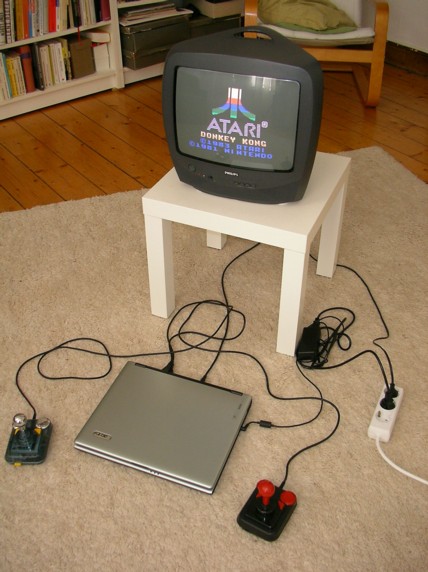
Lack the original hardware? No problem: You can recreate almost the ambience of 1983 just with equipment from 2007!
|
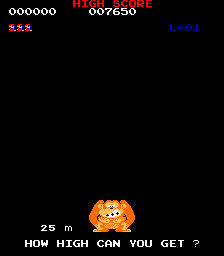 |
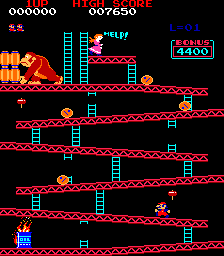 |
|
The first or 25m stage of Donkey Kong is called "Ramps". In order to finish the stage, Mario has to climb all the way up to Pauline. On his way, he must evade rolling barrels and flames by jumping over them. Instead of jumping, he can also grab a hammer and smash the obstacles. Some barrels take a short cut and roll down ladders or fall down directly. When a blue barrel reaches the oil drum a flame is released. Unlike the barrels, the flames can climb up ladders and change their movement direction. The latter makes it very hard to jump over them. In higher levels, some barrels fall down diagonally giving Mario an even harder time evading them. This stage does not have any "safe" place where you can pause Mario and grasp some air. In my opinion, this makes it the hardest of the four stages, in particular in the higher levels.
|
|
The second or 50m stage is called "Pie factory". It will only appear from level 3 on. The objective is again to get up to Pauline. Unlike in "Ramps" and "Elevators", Mario only has to reach the second highest beam (which actually is a conveyor belt) to complete the stage. Mario's foes are flames that periodically jump out of an oil drum in the center and pies that are carried on conveyor belts over the screen. To make it more complicated, the conveyor belts sometimes change their movement direction. The top two ladders are retractable and only climbable when extended. Of the four stages, this stage can be completed the fastest.
|
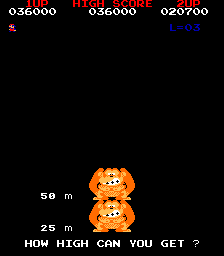 |
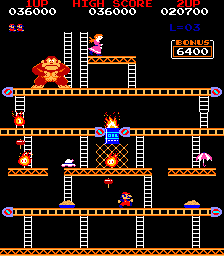 |
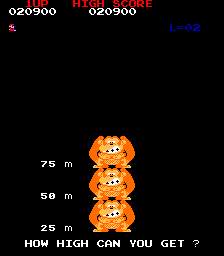 |
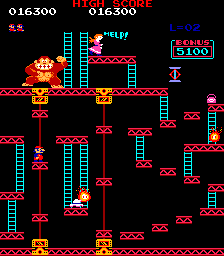 |
|
The third or 75m stage is called "Elevators". It is the most illustrious stage and only present from level 2 on. Mario has to hop between tiny isles of the scaffolding to get to Pauline. Elevators and jumping springs require good timing for any movement. Moreover, two flames move around and sometimes block landing pads forcing Mario to jump back to previous isles.
|
|
The final or 100m stage is called "Rivets". It is the top stage in all levels. Mario has to release eight rivets in the scaffolding by passing over them. Once released, the rivets disappear and create gaps that cannot be passed by flames and only be jumped over by Mario. If all eight rivets are released the center part of the scaffolding collapses causing Donkey Kong to fall down and be knocked out. This is the happy end of any level.
|
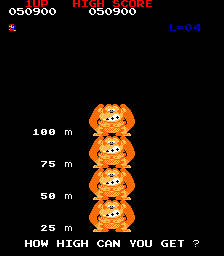 |
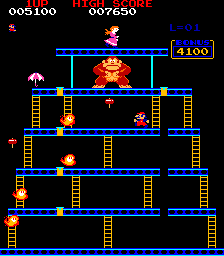 |
| | |
 |
| Game Speed |
Height |
Intro |
25m |
50m |
75m |
100m |
Final |
normal |
Yes |
Yes |
Yes |
Yes |
Yes |
Yes |
Yes |
Grade: A
The original Donkey Kong arcade machine is the benchmark for the descriptions of the portings below.
How to play it on a PC?
There is just one convenient emulator for original arcade games available and that is Mame. Fortunately, it is one of the best emulators ever written. However, it requires a little rigging to get the game to run.
|
 |
|
| | |
 |
| Game Speed |
Height |
Intro |
25m |
50m |
75m |
100m |
Final |
quick |
No |
No |
Yes |
No |
No |
Yes |
No |
Grade: D
The Atari 2600 port supplies only two of the original four stages and lacks all interludes.
The sound in this version is sparse and clanky as with most Atari games of this age.
The 25m stage is ok. However, the 100m stage appears a little clumsy as the flames are very predictable.
Due to these limiting features, the fun of playing wears out quickly.
Two things that stand out are the sprites of Mario and Pauline: despite the 2600's technical limitations they look quite similar to the original.
How to play it on a PC?
You will find tons of stuff for the Atari and the game on AtariAge.com. Personally, I use "Stella" as emulator. It is really easy to configure and use.
|
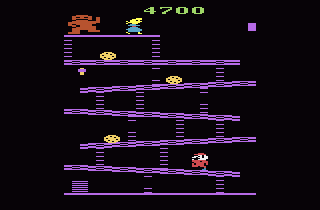 |
|
| | |
 |
| Game Speed |
Height |
Intro |
25m |
50m |
75m |
100m |
Final |
quick |
Yes |
Yes |
Yes |
Yes |
Yes |
Yes |
Yes |
Grade: B+
This version is a rather felicitous port of the game.
It has all the features of the original.
Moreover, the stages have been adapted to TV aspect ratio by leaving out the top beams of the scaffoldings.
Additionally, the sound is very close to the original.
If the collision detection wouldn't be so overly sensitive it would clearly be the best port of the game.
This way, it is only neck-and-neck with the C64 version. A curiosity of this version is that the start animation is not shown before a game but after a while when you leave the program unattended.
How to play it on a PC?
I recommend the Atari800WinPlus for emulating Atari 8-bit computers. It is very easy to use and even has a Kaillera client for internet play built in! A good place to get it with all the needed OS roms is at NeoTechGaming.com. The game image can then easily be attached.
|
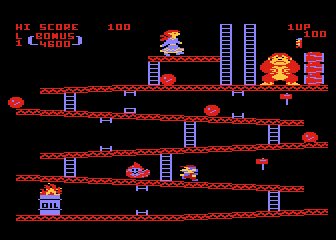 |
|
| | |
 |
| Game Speed |
Height |
Intro |
25m |
50m |
75m |
100m |
Final |
quick |
No |
No |
Yes |
No |
Yes |
Yes |
No |
Grade: C
The Coleco version comprises three of the original four stages leaving out the stage with the conveyor belts.
The graphics appear close to the original. In fact, the sprite of Mario is a 100% copy of the arcade version.
The sound is also very much like the original.
Sadly, none of the interludes have been implemented here.
Like the Atari 800 version, Coleco leaves out the top beams of the scaffoldings to better adapt to the TV aspect ratio.
One peculiarity of this version is that the 75m stage lacks the jumping springs. Instead, two more flames are
put on the screen.
Still, in comparison to the other console versions, this would clearly be the winner.
How to play it on a PC?
You want to get the KOLEKO v1.31. It is a single file with all games built in - no looking for OS or game roms and no installing. Very convenient!
|
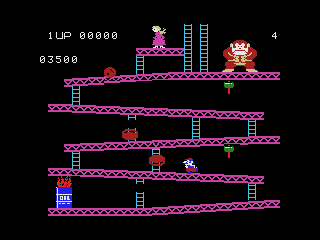 |
|
| | |
 |
| Game Speed |
Height |
Intro |
25m |
50m |
75m |
100m |
Final |
very fast |
Yes |
Yes |
Yes |
Yes |
Yes |
Yes |
Yes |
Grade: C+
Graphically being only between the Intellivision and Coleco version, this port is the winner when it comes to completeness. It is the only port that features all interludes and all four stages in the correct order.
Further, the sound is close to the original.
But its most outstanding property is the accelerated speed. It adds to the fun for good players but can drive novices crazy.
How to play it on a PC?
For emulating the VIC 20, give WinVICE a shot. It is a C64 and a VIC 20 emulator at the same time. To load the cartridge, you have to attach both banks at the indicated addresses and then reset the emulator.
|
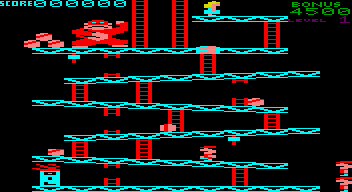 |
|
| | |
 |
| Game Speed |
Height |
Intro |
25m |
50m |
75m |
100m |
Final |
slow |
No |
Yes |
Yes |
Yes |
Yes |
Yes |
Yes |
Grade: B+
The C64 version seems very close to the original.
The only feature missing is the stack of gorillas that indicates the height before each stage.
The graphics are largely direct copies of the arcade version. In fact, it has the only Donkey Kong that really looks like the one from the arcade.
Unlike some of the other ports, this version displays all beams of the scaffoldings and streches the screen horizontally into TV aspect ratio. This lets the image appear a little "flat".
Unfortunately, Mario does not run faster on the wider screen, and so, the game speed becomes relatively slow.
This flaw puts the C64 version neck-and-neck with the Atari 800 port.
How to play it on a PC?
There are many C64 emulators around. Use WinVICE if you want to get a C64 and a VIC 20 emulator at the same time. The game can be found easily on the web or here.
|
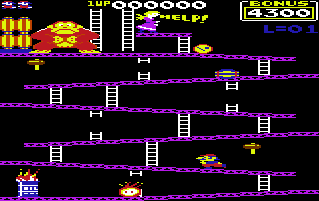 |
|
| | |
 |
| Game Speed |
Height |
Intro |
25m |
50m |
75m |
100m |
Final |
quick |
No |
No |
Yes |
No |
No |
Yes |
No |
Grade: D+
The Intellivision port has slightly better graphics than the Atari 2600 version, yet the monkey still looks rediculous and, unlike on the Atari, Mario and Pauline do too.
The sound of this version is rattling and not close to the original.
Apart from the graphics, the features are the same as the Atari console version.
The one thing that really feels different is the jumping: you have to start jumping way before an obstacle in order to get over it. This is a challenge to players who are used to the other versions.
How to play it on a PC?
I use Nostalgia for emulating the Intellivision. It is very easy to set up. You can find it at RomNation. Note that you need the OS roms to run Nostalgia (or any Intellivision emulator) with the game.
|
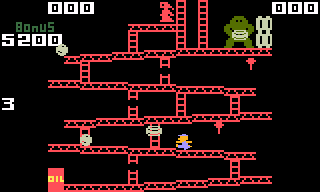 |
|
| | |
 |
| Game Speed |
Height |
Intro |
25m |
50m |
75m |
100m |
Final |
quick |
No |
No |
Yes |
Yes |
Yes |
Yes |
No |
Grade: B-
Graphically, the TI 99/4a version is good. Only Mario and the hammers look a little pallid. This port contains all four stages but none of the interludes. Similar to the Coleco version, the 75m stage lacks the jumping springs. But here, no additional flames were inserted. On the 50m stage, the top ladders are not retractable. These omissions make both stages easier than usual. The biggest flaw of this port is the dull and single-voiced sound. It kind of kills the arcade feeling. An oddity of this version is that the barrels start rolling before Mario first appears on the screen.
How to play it on a PC?
The easiest way to get TI99/4a-games to run on a PC is through Win994a. As of version 3 of this emulator, you additionally need the cartridge image to play the game. Older versions had the Donkey Kong game included.
|
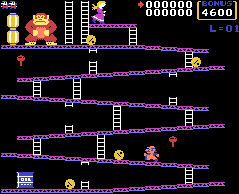 |
As mentioned above, this site is focused only on the technical features of early Donkey Kong versions. If you are looking for information concerning the sequels of the game or the story behind everything just follow one of the links below or search by yourself for the specific item on the web. The following links are an arbitrary selection:
If you think that there is anything important missing or even some inaccurate information on the site let me know.
Have a lot of fun!
Karawane
Legal disclaimer
There is no commercial interest related to this site. The material contained on this page is to the best of the author's knowledge freeware or abandonware, that is software for which the legal owner does not object to a free distribution or simply no longer exists. If you think you own the rights for any of the material presented on this page contact the author and he will instantly remove the respective item.
The author of this page is not responsible for any contents that can be reached through links given on this page. The opinions expressed on sites reached through those links do not necessarily reflect the opinion of this page's author.



















